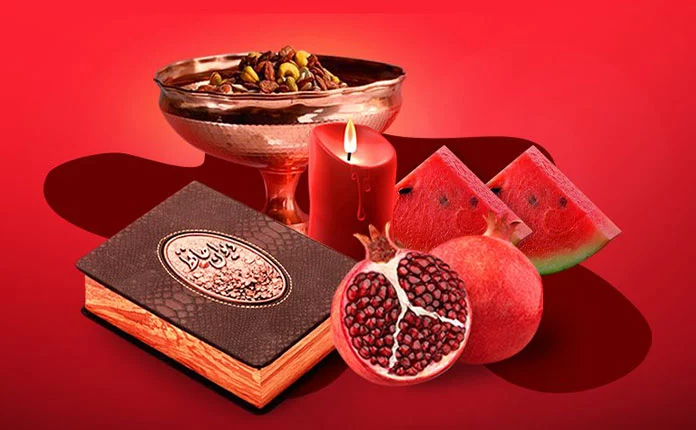Yalda night or Chelle night is one of the oldest Iranian festivals, which, like Nowruz, has been remembered from ancient Iranian history. This night is the longest of all nights of the year, and the ancestors of Iranians celebrated it every year.
Shab-e Yalda actually starts from sunset on the last day of autumn, i.e., December 30, and ends with sunrise on the first day of winter, i.e., January 1. The timing of Yalda night is equivalent to the night of December 21.
On this night, family members gather together and bring this longest night of the year to morning by reading Hafez’s poetry and eating fruit.
The history of Yalda night
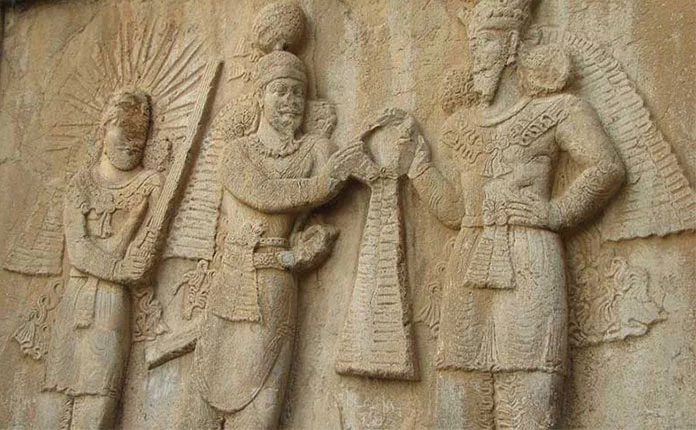
Yalda night is said to be the last night of autumn and the longest night of the year, technically only about a minute longer, but it holds immense importance for Iranians. Holding the Yalda night ceremony among Iranians is more than seven thousand years old. In fact, Iranians have long recognized that the first night of winter is the longest night of the year. Although throughout Iran’s history, governments did not see the need to observe this night, Iranians have cherished Yalda for a long time.
Yalda night entered the official calendar of ancient Iranians in 502 BC during the reign of Darius I.
The people of ancient times were engaged in animal husbandry and agriculture, adjusting their lives based on nature. The change of seasons and the length of night and day had a significant impact on their lives. Therefore, they attached special importance to the light, warmth, and length of the days, considering it good and pleasant. However, winter, cold, and long nights were not very pleasant for them.
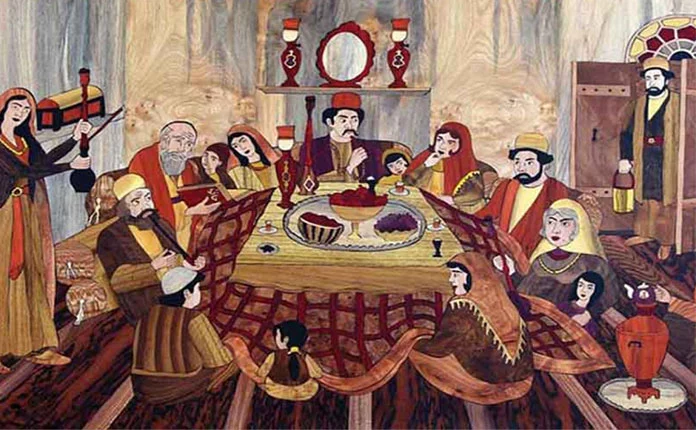
In the Mehr ritual, the last night of autumn is considered the birthday of the sun, when Izadmehr emerges from a cave in the Alborz mountains during the darkness of a long and cold night, bringing the bright sun. Shab Cheleh is actually the night symbolizing the birth and emergence of the sun. In the book “From Myth to History,” Dr. Mehrdad Bahar is quoted: Yalda night is not the birthday of Mehr or Mitra; Instead, it signifies the birth of the sun. Mehr holds distinctions from the sun.
According to the calendar of the ancient Iranian people, Chelle coincides with the night of the sun’s birthday, and even though the sun and the moon are closely related, they are not the same. After the Iranians converted to Zoroastrianism, the customs of Mehr became part of Zoroastrianism. According to what is stated in the book of Athar al-Baqiyya, Zoroastrians considered the first day of Day as “Khorrooz” or the same as the day of the sun, and called the celebration held on this day “Nowruz”; because the time period from Yalda night to Nowruz was 90 days. According to the contents of Masoudi’s law book, the first day of January was called “Khorramroz” and was attributed to Ahura Mazda. When the Zoroastrian religion was introduced as the official religion of the country in the Sassanid era, the importance of the seal ritual in government institutions and in people’s lives was still evident.
Yalda night customs
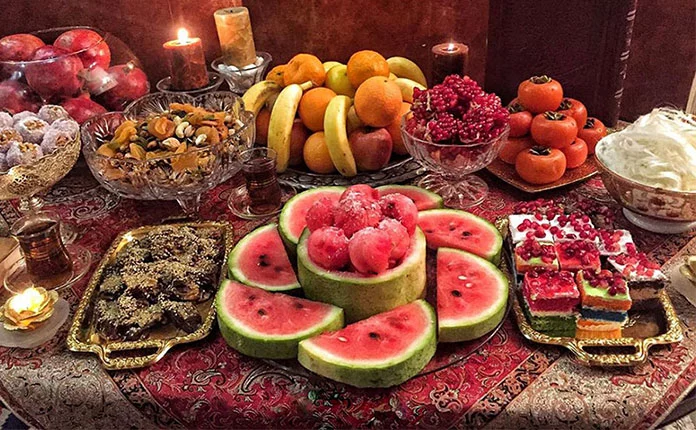
The Yalda celebration is similar to Iranian celebrations; it is held as a family gathering, and during this ceremony, a table with special foods is featured. In most areas, these foods are called “nightchereh” and often consist of seven types of nuts and seven types of fruit. However, sometimes there are more than seven types, including both traditional and non-traditional sweets. A few days before Yalda night, there is a lot of excitement in the streets and markets, with people shopping and preparing for this ancient festival. Many vendors also sell food for this night in the city. This celebration is often hosted by elders, making it memorable and unforgettable. The most significant part of this celebration can be considered the gathering of family members and relatives who spend the longest night of the year happily, engaging in conversation together.
Check out some of the acts taking place this night below:
Reading Hafez’s poetry
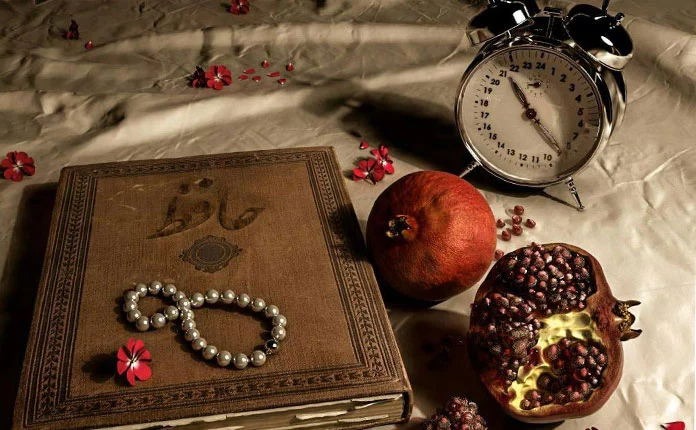
Divan Hafez” (The book of Hafez’s poems) has a special place on Yalda night’s table, and guests open the book during the gathering to learn about their future by reading his poems.
Eating nuts
The most popular and delicious part of Yalda night is dedicated to consuming nuts, which are often a combination of dried fruits and nuts that have many properties.
Eating fruits
Iranians are not only content with nuts on Yalda night; all kinds of fruits can be seen on their Yalda table. One of these fruits is watermelon, without which Yalda night is not complete. It is believed that by consuming a fruit symbolizing summer, they will not be affected by the cold during winter. Pomegranate, as a symbol of happiness and birth, is a constant part of the Yalda night spread. This delicious and juicy fruit aids in blood formation, provides ample energy, and vitality to humans due to the presence of vitamin C and other beneficial properties.
One of the interesting points about Yalda is that watermelon and pomegranate serve as symbols of this night. But do you know why?
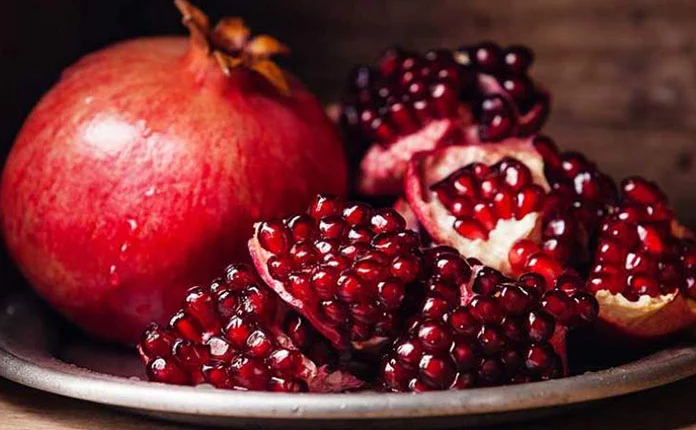
The significance of the red color spans a history of five thousand years. Before settling in the current Iranian plateau, Iranians originated from a region with 10 months of winter and two months of summer. Hence, the sun’s warmth held immense importance to them. Consequently, everything associated with the sun, such as the purplish hue of dawn, held deep value. The significance of the red color on Yalda night also stems from this aspect, and the color of these two delicious fruits is linked to the belief in the purplish color of dawn.
dinner
Since Yalda night is an ideal opportunity to reunite with relatives, everyone goes out of their way to prepare a delicious dinner. The food eaten on this night, depending on each city, can include sabzi pilaf with fish, barberry pilaf, pomegranate pilaf, Shirazi cabbage pilaf, etc., doubling the pleasure of being together.
Finally
Yalda night (that we called shab-e yalda) is one of the most important ancient festivals of Iran, which we introduced in this blog. As a travel tip, you should know that if you travel to Iran at the end of autumn and the beginning of winter, you will definitely see signs of this celebration in the alleys and streets. For example, undoubtedly, all the hotels change their decor to the theme of Yalda night, and wherever you step, you will encounter the atmosphere of Yalda night.
